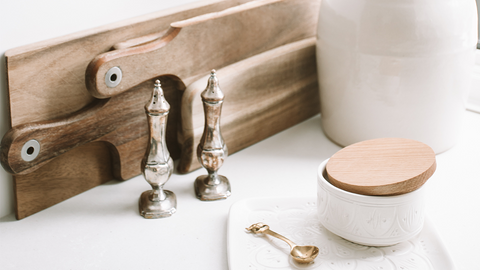Categories
- Cookware
- Bakeware
- Cutlery
- Coffee Machines and Accessories
- Smoked Cocktail and Food Tools
- Personal Care
- Wellness Mats
- Made In
- Kettles
- Greeting Cards
- Kikuichi Cutlery
- Marcato
- Smithey Ironware
- Cheese
- Funky Chunky
- Products of Scotland
- Meat N' Bone
- Millican Pecan
- Porter Road
- Xocolatl Small Batch Chocolates
- Heritage Steel
- Middleton Made Knives
- Diabetic Kitchen
- Chocolates
- Water Filtration Systems
- Copper State Forge
- Preparation, Organization & Storage
- Butcher Block/Cutting Boards
- Textiles, Towels and Aprons
- Fruit & Vegetable Tools
- Food
- Artisanal Spice Shop
- Brining, Basting & Roasting
- Tongs
- Cleaning & Sanitizing
- Spatulas & Turners
- Smoked Food Tools
- Ceramic & Glass
- Cheese Brothers
- Asheville Tea Company
- Coffee
- Specialty Tools
- Wine & Bar Accessories
- Seafood Tools
- Chocolates
- Coffee Makers
- Coffee & Tea Accessories
- Ladles, Whisks & Spoons
- Bitters & Mixers
- Grilling
- Measuring Cups & Spoons
- Serving Tools
- Zesters & Graters
- Coasters & Magnets
- Openers, Funnels & Strainers
- Oil & Vinegar
- Scales
- Temperature & Time
- Salt and Pepper Mills, Storage & Shakers
- Kitchen Appliances
- Bowls
- Flavoring & Food Coloring
- Vitamix
- Egg & Butter Tools
- Chef Apparel
- Anti-Fatigue Mats
- Jura
Featured posts
Short Rib Cubes | A5 Hannari Japanese Wagyu


Learn about how we label beef and Beef Grading Standards
Short Rib is among the most flavorsome cuts of beef from the steer. Exceptionally marbled and tender, proper preparation yields these ribs as some of the most savory pieces of beef from the steer.
Appropriate for searing, these rich & fatty cubes can also be cooked in various ways, such as with indirect heat, smoking, or even braised.
About A5 Hannari Beef
In Japan it is believed that the quality of meat from female Wagyu cattle is higher than that of male Wagyu cattle (cows have smaller muscles than bulls and steers). There is certainly a more refined flavor profile and a silkier texture. We came, we tried and we loved it.
Hannari beef is raised in a multigenerational family farm located in the prefecture of Kyoto, Japan, a farm of breeders that focused on only select female cows... hence there is a very limited production of less than 250 female cows per year. They are raised in an idyllic environment.
The farm is surrounded by the mountains of Tamba and it is blessed with clear underground water. The cows are raised in a stress-free environment, to the point that it is hard to hear any mooing (cows moo when they are stressed). The cows are fed a different diet depending on their stage of growth and the diet is modified according to the temperature of the day.
Our agreement with Hannari beef means we only get the cream of the crop, the cows that grade BMS12.

A5 beef is measured on five factors: (1) marbling, (2) meat color and brightness, (3) firmness and texture of meat, and (4) color, luster, and quality of fat.
In the quality grade, the lowest score from the four items of the yield grade is adopted. In other words, even if grade 5 was given to marbling, color and brightness, and firmness and texture, and only fat assessment was grade 4, the quality grade of this beef is classified as grade 4. Quality grading is severely done.
A5 means this beef excels in every single factor. It has a gorgeous webbing of fat that will make you feel a creamy mouthfeel in each bite. It's literally like tasting a cloud... a cloud of beef.
Like all of our steaks, they come vacuum sealed and have been hand-cut by our expert butchers.
Never Had A5 Wagyu Beef Before?
At first glance, every cut of A5 beef will be EXTREMELY fatty compared to any other steak you have ever had. That delicate and yet rich fat, which can make up more than 60% of the steak is what makes it melt in your mouth.
This amount of fat makes the beef have a lower melting point, meaning it will cook faster than your average steak. Cooking A5 is extremely easy, that said... it is recommended to pay close attention so that you do not burn or overcook your steaks.

Best Cooked: Medium-Rare, Medium
Source: Kyoto, Japan































































































